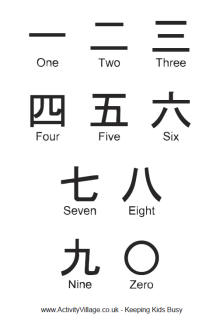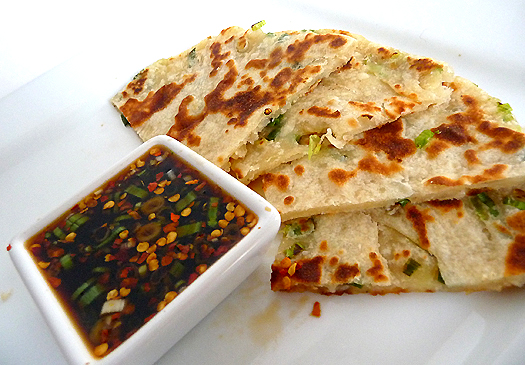I have discovered something truly great about this blog: it's a great way for me to procrastinate, while still feeling like I'm getting something done. And while we're on the topic of my admirable study habits, I'd like to share a story my parents told me when I was younger:
This week's practice characters included the numbers one through ten, which I luckily already knew. The nice thing about Chinese numbers is that, once you know one through ten, you know all of them! Here's how it works: numbers larger than ten are kind of like "compounds". You break them up into the different parts of the number. For example, the number twenty-three is 二十三 - both written and pronounced "two ten three". Once you get to 100 and larger numbers, you use different characters (they're not based around ten anymore), but this makes Chinese counting a lot simpler than English (how are we supposed to know that "twenty" is two tens??). Malcolm Gladwell actually proposes in his book Outliers that the simplicity is part of the reason why Chinese students score so well on math tests - because they have an easier time counting in early childhood.One day, a boy went to school. There at school, the students were learning how to write numbers. The teacher started with the character for one (yī). It is, as you will observe, a single line: 一. Then, the teacher moved on to two (èr). It was two lines: 二. Next, the teacher taught them how to write three (sān). As the boy predicted, it was three lines: 三. After seeing this, the boy got up and said, "Well, I know how to write numbers now!" And promptly went home. After staying out of school, for a few days, the boy decided to return. That day, the students were taking a test on how to write numbers. The boy thought it would be easy - until the teacher asked them to write "one thousand" in Chinese!
Chinese numbers 0-9
The Struggle is Real
This week's characters were a bit harder than the previous week's - mostly because they're building in difficulty. By difficulty, I mean the obscurity of the word. Not that I'm learning how to write "enigma" or "relentless" in Chinese, but that these characters aren't the most obvious ones that I still remember from Chinese school. In other words, I didn't recognize most of these characters (compared to last week, when I did recognize a good number of them). This was a little challenging, but I employed the help of Dani, who apparently is a lot more creative than I am (honestly, who knew?). I would go through my flashcards with her, and if I was stuck on a word, she would usually help me find some sort of visual cue to help me remember it. For example, I was stuck on the word kè (guest) for a really long time. I eventually realized that the character 客 had a little kǒu (口) on the bottom. This character by itself can mean mouth or opening. And I thought to myself - you would open your home to a guest, so it makes sense that there's an opening in the character for guest. I have no idea if that was intentional, but now I never forget it!
I've also been struggling with proportions. If you've seen my handwriting in real life, you'll know that
 |
| Some grids for Chinese practice |
 |
| Practicing on graph paper |
That's Totally Radical, Bro
Believe it or not, Chinese radicals are actually automated buttons you can attach to a skateboard, and they say "bruh" every time you do something totally gnarly.
I'm sorry, that's not actually what they are, and the day someone invents that is the day I enter permanent hibernation underneath Earth's crust. Chinese radicals are called 部首 (bù shǒu), literally "section header". Many Chinese dictionaries come with an index for radicals, and the most commonly accepted table includes 214 radicals (again, why would Chinese ever be easy?). You can think of radicals like prefixes or suffixes: they're often attached to or appear on Chinese characters, and they can sometimes hint at the meaning of a character. Radicals can appear on the top, bottom, left, right, or in the middle of characters. They can make learning Chinese simpler, but I wouldn't recommend trying to memorize all of them. You're better off just noticing when they appear and making connections.
 |
| If you've ever had nightmares about verb tables, this is way scarier. For definitions, check out this website |
Returning to the Struggle
I also need to show you the practice sentences I wrote this week. As I learn more words, I'm getting excited because I can finally express my thoughts on paper, instead of solely verbally.
- Girls learn English.
- Your name is...
- I sit on the ground.
- He lives in the courtyard.
- Your child is a foreigner. (Note: "foreigner" has some negative/insulting connotations in English; this isn't the case in Chinese.)
- I ask you.
- This painting is very expensive.
Some of these sentences are a bit awkward in Chinese because I haven't learned how to write some of the nonsense phrases that make things sound more natural. For now, I'm trying to use new vocabulary, but also mix in words that I learned last week.
Also, I should tell you that, on my flashcards, I've been putting the pinyin (phonetic version of the characters, coming later in a blog post) and German translations of the word. Usually, I can recognize the character with just the pinyin, but I like putting the German to exercise all my language skills. Interestingly, I had the word 宿 (sù) this week. It means "to stay overnight". Obviously, we don't have a single-word English translation for this....but the German verb übernachten is a perfect translation. Funny how languages work, right?
There is one more thing I want to show you (before we get to the cute animals...): Chinese cursive! Most people only use cursive as a sort of shorthand, or just for aesthetic design purposes. I know I'm not exactly literate in Chinese, but I can hardly read it. Imagine your doctor writing in that!
 |
| Regular writing (left) vs. Cursive (right) |
- Jess
Resources















